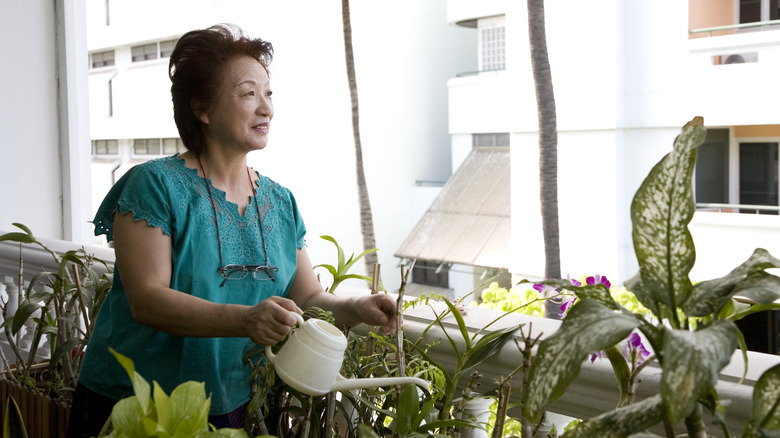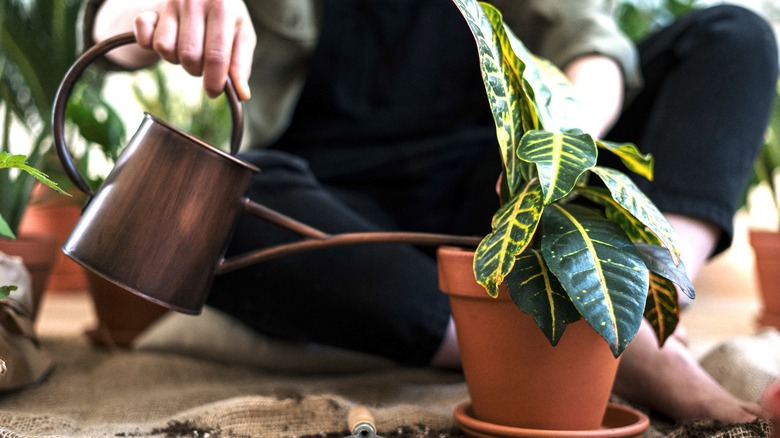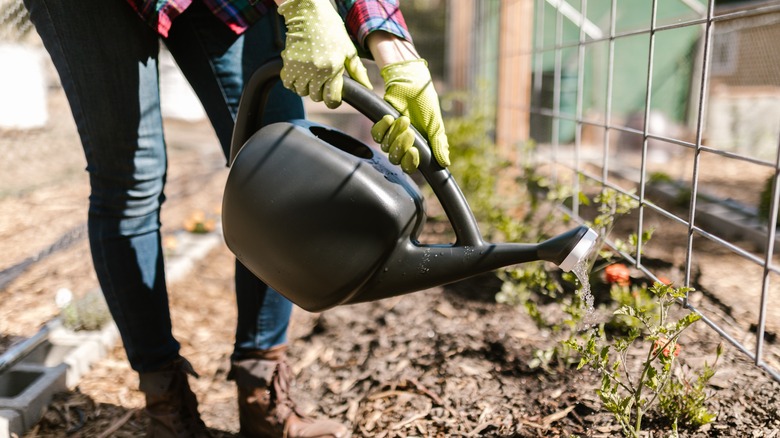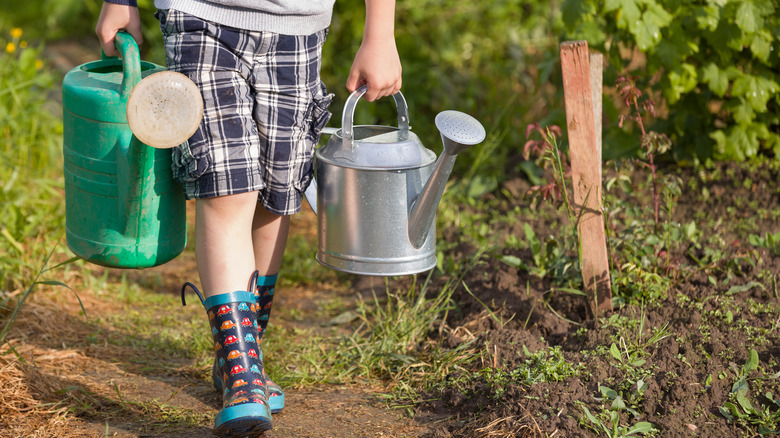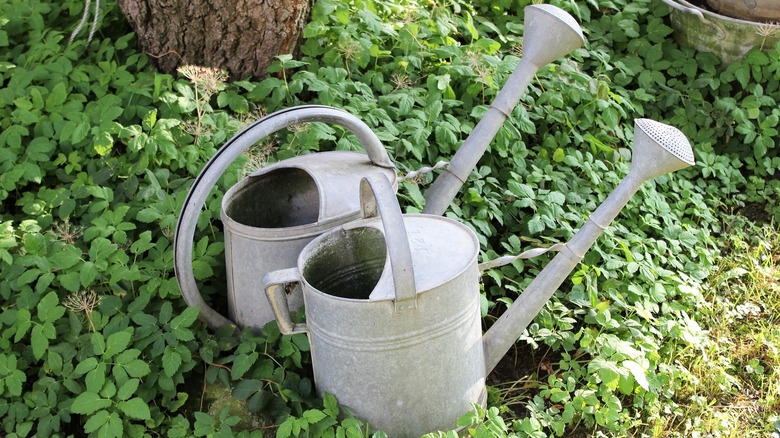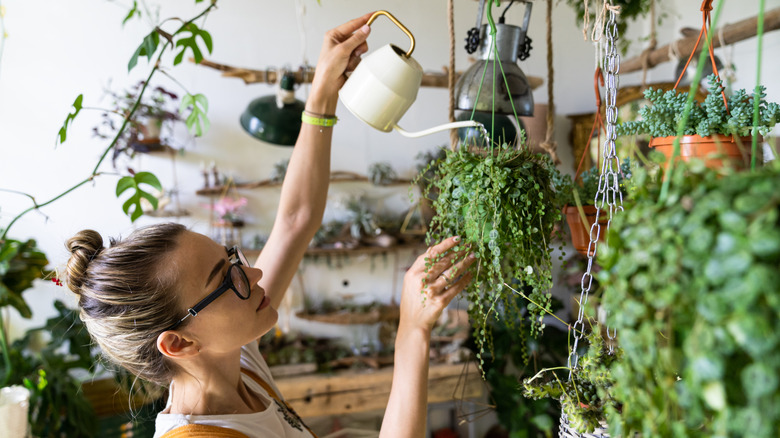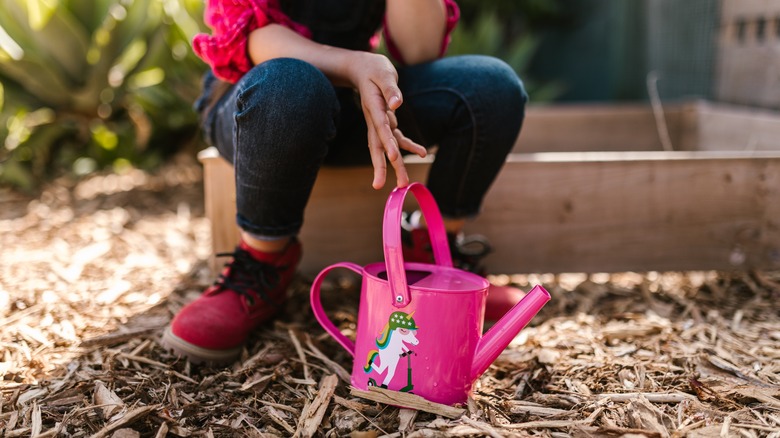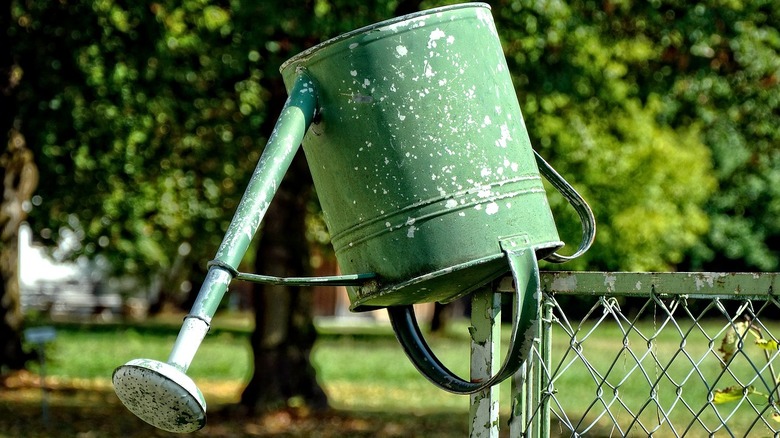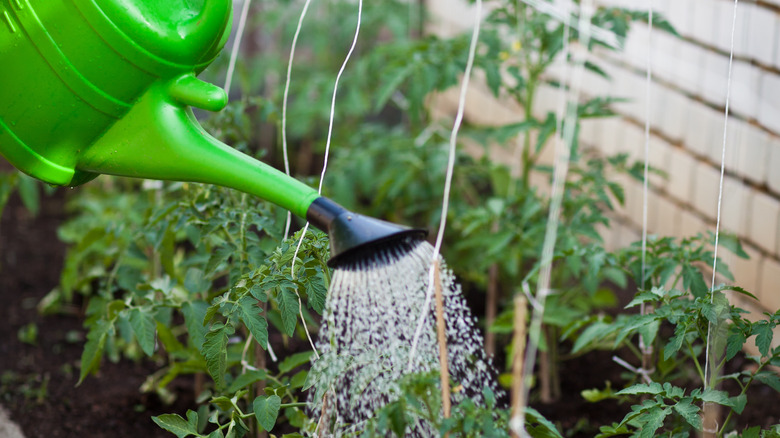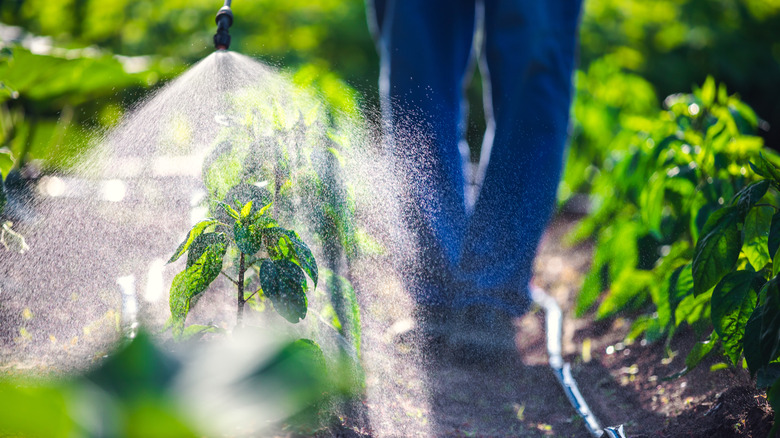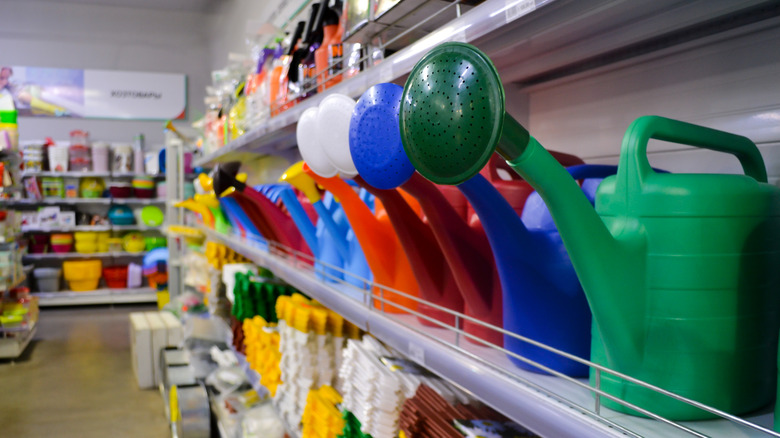Things To Keep In Mind While Shopping For A Watering Can
People have been using watering cans since as early as the 17th century, and although their styles have evolved since then, their general purpose remains the same. Even now, over 300 years later, watering cans are a staple in most gardeners' tool collections. These simple but effective instruments enable people to water their plants with more control over the water flow and amount. Whether you have indoor or outdoor flowers, vegetables, or herbs to water, these specialized buckets are necessary for keeping your plants healthy and hydrated throughout the year.
There is no universal design best suited for everyone, and you should be deliberate in choosing an option that fits your watering needs. There are several considerations to keep in mind while shopping online or in person, including material makeup, water capacity, spout, and nozzle design. Learn more below about the qualities you should look for in a watering can, so you can make the best purchase for your situation.
Should you choose a metal watering can?
The material makeup of a watering can greatly impact its price, upkeep, and overall functionality, and most manufacturers use metal or plastic. The type of metal used can vary. They are often made from copper, stainless steel, tin, zinc, galvanized metal, and other engineered combinations. Generally, all metal types are long-lasting and heavy-duty, making them great options for people who aren't gentle with their gardening tools. However, their strong composition also makes them heavier to carry, which may be an issue for those who lack upper body strength. Some metal cans are also more prone to rusting unless they are coated in a specialized finish or crafted from engineered materials.
Two types of metal cans that have specialized properties are copper and galvanized metal. Copper is a naturally occurring chemical element that also serves as an essential micronutrient for plants. It's known to increase disease resistance and improve a plant's ability to carry out photosynthesis, and exposure to this material can provide these benefits. Galvanized metal is also notable for being one of the most optimized and functional materials on the market. These cans are relatively cheap, require lower maintenance, and have protective properties without any additional coatings or finishes.
Should you opt for a plastic watering can?
Metal watering cans have their advantages and disadvantages, but there is another suitable option for you to choose from. Plastic products are an awesome alternative to traditional metal styles for many reasons, and they are commonly made from Polyvinyl Chloride (PVC), Polyethylene (PE), and Polypropylene (PP). To find what type of plastic a product is made from, you can look for the abbreviated lettering that is etched on the bottom beside the recycling symbol. PVC products are of higher quality than PE and PP-based watering cans and have a higher resistance to damage, heat, and general wear and tear over time.
Manufactured plastic designs are favored for their low prices, lightweight build, and decent durability. They aren't vulnerable to rust like metal options, but they can be more prone to cracking over long-term use. These styles come in a variety of colors and shapes, making them more diverse than traditional cans. However, despite the array of fun shapes and patterns, they aren't considered as aesthetically pleasing as their tougher counterparts. PVC, PE, and PP cans tend to serve a solely functional purpose, while metal is used for both interior decor and gardening ventures.
What capacity is most practical for your garden?
Another large difference between watering cans is their overall water capacity, and common sizes can range between one to several gallons. When deciding what capacity you need, you should keep the overall weight of the can in mind. The more gallons of water it holds, the heavier it will be. Five gallons of water weighs between 41.7 and 44 pounds, depending on the water's composition. This means that in addition to the watering can's material a full five-gallon one may weigh around 50 pounds when full. This just may not be practical for lugging around your garden or home.
If you need a larger size to water your plants efficiently, consider getting two smaller cans instead of one large one. With two smaller containers, you can hold one in each hand, making it easier to distribute the weight as you walk. In addition to considering your own strength, you should consider the plants you're watering. If you're buying a watering can just to sustain a few small indoor house plants, a five-gallon receptacle will be unnecessary and awkward to pour. A smaller can will be a more convenient option that will hold plenty of water for your needs.
What kind of handle do you prefer?
While browsing for watering cans, you'll notice a variety of handles to choose from. Some handles are made from the same material as the rest of the design, while others are crafted differently for aesthetic or functional reasons. They also come in different shapes and styles. Some are curved while others are straight extended pieces.
Plastic watering cans are often simple in form and have identical plastic handles, while metal types are more likely to be topped off with specialized grips. Higher-quality designs have non-slip, grooved handles, which are comfortable to clutch. These ergonomic handles have the size, shape, and consistency to be well-fit for most adult-sized hands, optimizing their everyday use. People with arthritis, carpal tunnel, or other hand and wrist issues should lean toward ergonomic watering cans to avoid triggering their condition. If the can you want doesn't have a user-friendly handle, you aren't completely out of luck. Many general retailers and home improvement stores sell handle wraps and grip tape, which you can wrap around the metal or plastic.
What type of spout do you need?
Another discerning factor between metal and plastic cans is the size and style of the spout. Spouts vary in length, width, and shape, making certain designs more practical for certain gardening tasks. Shorter styles are better for watering indoor house plants if your pots and planters are placed in easily accessible locations. Generally, longer spouts are better for most watering jobs — you can reach plants on high shelves and water outdoor plants without crouching down.
Spouts crafted in thinner or curved shapes deliver a slower and steadier stream of water, which can help prevent overwatering or overwhelming sensitive plant life. Meanwhile, thicker and straight-shaped spouts are better for drenching greenery that requires substantial watering. If you need a watering can for various jobs, you should know that there are options with adjustable spouts that can be extended or shortened. Some spouts can even be removed entirely, allowing you to customize your watering can to meet your specific needs.
How many watering cans do you need?
It was previously mentioned that you should purchase duo watering cans if you have a lot of plants but don't want to injure yourself by carrying too much weight. However, you should also consider purchasing multiple if you live with other people interested in gardening. Your partner, roommates, or children might want to help you water plants on occasion, and purchasing watering cans for them will pique their interest.
Plastic types are often sold in sets online, allowing you to purchase multiple for a reduced price. You can also buy various sizes of the same style to ensure you have the right kind for all plants inside and outside your home. When purchasing for kids, it's highly recommended that you choose a small plastic can made for younger individuals. These options have smaller handles, they're lightweight, and they often come in cute, colorful designs that appeal to children. Some are even shaped like animals or come with other gardening tools.
How will you store your watering can?
Before committing to a purchase, consider where you will store this new tool. If you already have a burgeoning gardening tool collection, the most practical location is with your other supplies. Remember, your watering can will last longer if stored indoors and out of moist environments. No matter which material your can is made of, it should be stored upside-down to make sure it's well-drained. This is especially important for metal cans since constant water exposure can lead to rust buildup and corrosion. A rusty watering can potentially harm your plants and through off your soil's pH balance. Plus, you also want to avoid corrosion since it weakens and breaks down the material over time.
If you plan on leaving your can outside, you should opt for a plastic design. Plastic also deteriorates faster when left outdoors, but rain and humidity have less of an impact on this material than metal. If you have limited space, there are some watering cans specifically built for easy storage. You can find collapsible cans and cans with foldable spouts that make them more compact when not in use. Just make sure to let them dry out before collapsing them for storage.
Do you need any additional accessories?
There's no shortage of additional watering can accessories to make your new purchase more advantageous. In addition to ergonomic hand grips, you can purchase nozzle attachments for the end of the spout. These are especially helpful for gardeners with multiple containers and beds as they allow you to change the water pressure and flow as needed. These nozzles come in metal or plastic designs. Like the watering cans themselves, metal nozzles can be more expensive but tend to last longer. Meanwhile, plastic nozzles are lighter and cheaper but can be more prone to cracking and breaking over time.
Before you purchase any accessories to go with your can, make sure they are compatible. Due to the various styles of vessels on the market, not all cans and accessories properly fit together. Many gardening manufacturers sell accessories specifically built for their products, and you should purchase additional attachments through them to ensure a correct fit.
Would an electrical watering can be a better solution?
Most of these considerations focus on traditional-style watering cans, but you should know that there are modern innovations when it comes to this tool. Electrical watering cans are either battery-powered or charged with an electrical cord. Certain models deliver specific flow rates with the press of a button and can be programmed to precise water measurements and pressure. They are also adjustable to spray from short to long distances and are usable indoors and outdoors.
These types of cans are also beneficial for their ergonomic features. Since they are electrically powered, it takes minimal effort to press a button and water your plants. This keeps you from making repetitive actions that can lead to muscle strain or injuries while gardening. However, due to their technical qualities, these cans tend to be pricier than non-powered designs. Their durability greatly varies since there are both physical and technical components to maintain over time.
Watch for good deals
Functional watering cans don't tend to be expensive purchases, but a savvy shopper always watches for good deals. Many home improvement stores have regular sales surrounding certain holidays. Since many people are off for long weekends they can hit the hardware store and can tackle home and garden projects. Presidents' Day, Memorial Day, and Labor Day are great times to check out local deals.
Remember you can also save money by not purchasing your watering can brand new. They are common thrift and secondhand shop items, and you can pick them up used. Make sure to inspect any used watering cans for cracks, holes, or corrosion before purchasing. Also, be careful to not accidentally purchase a watering can meant solely for decorative purposes. Farmhouse interior decor is in, and not all ornamental watering cans are optimized for carrying water and sustaining your garden. They may not be fully sealed on the bottom, or the material may be ruined by constant water exposure.
